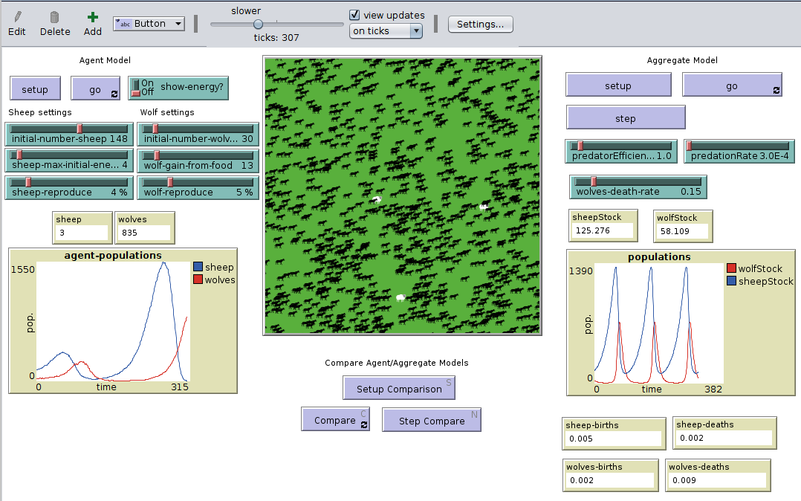NetLogo: Difference between revisions
| Line 36: | Line 36: | ||
The following screen capture shows a comparison between an agent-based and a simulation-based predation model. In the agent model the wolves at some point will eat all the sheep and then die out. In the simulation model, populations can recover since fractions of a single wolf or sheep are allowed .... | The following screen capture shows a comparison between an agent-based and a simulation-based predation model. In the agent model the wolves at some point will eat all the sheep and then die out. In the simulation model, populations can recover since fractions of a single wolf or sheep are allowed .... | ||
[[image: netlogo- | [[image: netlogo-agent-vs-system-dynamics-1.png|none|thumb|801px|Agent vs. system dynamcis. Only 3 sheep left in the agent model after 307 ticks]] | ||
Netlogo includes additional features, consult the [http://ccl.northwestern.edu/netlogo/ NetLogo web site]. | Netlogo includes additional features, consult the [http://ccl.northwestern.edu/netlogo/ NetLogo web site]. | ||
Revision as of 14:56, 11 March 2019
Introduction
“NetLogo is a cross-platform multi-agent programmable modeling environment. NetLogo was authored by Uri Wilensky in 1999 and is under continuous development at the CCL (the people who brought you StarLogoT). NetLogo also powers the HubNet participatory simulation system”. Netlogo can be used both to teach programing, model building and understanding of complex phenomena through models.
NetLogo can be described as a programming microworld. It is officially described as a programmable modeling environment for simulating natural and social phenomena. “NetLogo is particularly well suited for modeling complex systems developing over time. Modelers can give instructions to hundreds or thousands of "agents" all operating independently. This makes it possible to explore the connection between the micro-level behavior of individuals and the macro-level patterns that emerge from the interaction of many individuals.” (What is NetLogo?, retrieved 09:54, 18 September 2009 (UTC))
“NetLogo is a cross-platform multi-agent programmable modeling environment. NetLogo was authored by Uri Wilensky in 1999 and is under continuous development at the CCL (the people who brought you StarLogoT). NetLogo also powers the HubNet participatory simulation system”.
NetLogo is a free environment and as of Feb 2019 is still under active development and a large model library. We tested this under Windows 10 and Ubuntu 18. - Daniel K. Schneider (talk) 11:40, 11 March 2019 (CET)
See also AgentSheets
The software
NetLogo is free and runs on must systems (since it is programmed in Java)
Creating simple agents
It has an easy to use graphical interface to create simple simulations. You may create a world and parametrize turtles that move around. At some point one then can add programming logic to these objects. Have them move around more smartly, interact with others or with the place on which they currently sit. Turtles can have any shape, i.e. a car.
Netlogo simulations
In addition to a learning environment for agent-based programming, NetLogo is a modeling and simulation tool of several kinds.
(1) Firstly you can do agent simulation (i.e. the turtles interact with each other and the environment). You may play with parameters and use the “BehaviorSpace [...] software tool integrated with NetLogo that allows you to perform experiments with models. It runs a model many times, systematically varying the model's settings and recording the results of each model run. This process is sometimes called "parameter sweeping". It lets you explore the model's "space" of possible behaviors and determine which combinations of settings cause the behaviors of interest.” (BehaviorSpace)
(2) The System dynamics allows to model dynamic systems (e.g. like the modules you may find in Cool Modes or with the old commercial Stella program).
The System Dynamics (retrieved 09:54, 18 September 2009 (UTC)) defines the difference between the two models like this: “With the agent-based approach we usually use in NetLogo, you program the behavior of individual agents and watch what emerges from their interaction. In a model of Wolf-Sheep Predation, for example, you provide rules for how wolves, sheep and grass interact with each other. When you run the simulation, you watch the emergent aggregate-level behavior: for example, how the populations of wolves and sheep change over time.”
(3) With the Hubnet model you may “run participatory simulations in the classroom. In a participatory simulation, a whole class takes part in enacting the behavior of a system as each student controls a part of the system by using an individual device, such as a networked computer or Texas Instruments graphing calculator.” (HubNet, retrieved 09:54, 18 September 2009 (UTC)).
The following screen capture shows a comparison between an agent-based and a simulation-based predation model. In the agent model the wolves at some point will eat all the sheep and then die out. In the simulation model, populations can recover since fractions of a single wolf or sheep are allowed ....
Netlogo includes additional features, consult the NetLogo web site.
For researchers
NetLogo has a configurable logging feature to study user behavior and interaction.
Links
- NetLogo HomePage. This website includes the downloads, user manual, extensions, ready models from a library, etc.
Bibliography
Wilensky, U. (1999). NetLogo. http://ccl.northwestern.edu/netlogo/. Center for Connected Learning and Computer-Based Modeling, Northwestern University, Evanston, IL.
Wilensky, U & Rand, W. (2015). Introduction to Agent-Based Modeling: Modeling Natural, Social and Engineered Complex Systems with NetLogo. Cambridge, MA. MIT Press.
Kornhauser, D., Wilensky, U., & Rand, W. (2009). Design guidelines for agent based model visualization. Journal of Artificial Societies and Social Simulation, JASSS, 12(2), 1.
